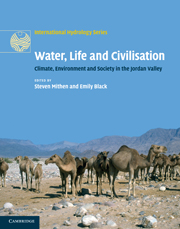Book contents
- Frontmatter
- Contents
- List of figures
- List of tables
- List of contributors
- Acknowledgements
- 1 Introduction: an interdisciplinary approach to Water, Life and Civilisation
- Part I Past, present and future climate
- 2 The present-day climate of the Middle East
- 3 Past climates of the Middle East
- 4 Future climate of the Middle East
- 5 Connecting climate and hydrological models for impacts studies
- Part II The palaeoenvironmental record
- Part III Hydrological studies of the Jordan Valley
- Part IV Human settlement, climate change, hydrology and water management
- Part V Palaeoeconomies and developing archaeological methodologies
- Part VI Society, economy and water today
- Part VII Conclusions
- Index
- Plate section
- References
3 - Past climates of the Middle East
from Part I - Past, present and future climate
Published online by Cambridge University Press: 26 April 2011
- Frontmatter
- Contents
- List of figures
- List of tables
- List of contributors
- Acknowledgements
- 1 Introduction: an interdisciplinary approach to Water, Life and Civilisation
- Part I Past, present and future climate
- 2 The present-day climate of the Middle East
- 3 Past climates of the Middle East
- 4 Future climate of the Middle East
- 5 Connecting climate and hydrological models for impacts studies
- Part II The palaeoenvironmental record
- Part III Hydrological studies of the Jordan Valley
- Part IV Human settlement, climate change, hydrology and water management
- Part V Palaeoeconomies and developing archaeological methodologies
- Part VI Society, economy and water today
- Part VII Conclusions
- Index
- Plate section
- References
Summary
ABSTRACT
In this chapter, we develop an improved understanding of the Mediterranean's past climate through a series of ‘time-slice’ climate integrations relating to the past 12,000 years, performed using a version of the Met Office Hadley Centre's global climate model (HadSM3). The output is dynamically downscaled using a regional version of the same model to offer unprecedented spatial detail over the Mediterranean. Changes in seasonal surface air temperatures and precipitation are discussed at both global and regional scales along with their underlying physical drivers.
In the experiments the Mediterranean experiences more precipitation in the early Holocene than the late Holocene, although the difference is not uniform across the eastern Mediterranean. The results suggest that there may have been a relatively strong reduction in precipitation over the eastern Mediterranean coast during the period around 6–10 thousand years before present (kaBP). The early Holocene also shows a stronger seasonal cycle of temperature throughout the Northern Hemisphere but, over the northeast Mediterranean, this is mitigated by the influence of milder maritime air carried inland from the coast.
INTRODUCTION
Understanding the changes in the Mediterranean climate during the Holocene period is a challenging problem, but one that is critical to interpreting long-term change in human settlement. The region at present displays marked seasonality with dry, hot summers and cool, wet winters.
- Type
- Chapter
- Information
- Water, Life and CivilisationClimate, Environment and Society in the Jordan Valley, pp. 25 - 50Publisher: Cambridge University PressPrint publication year: 2011
References
- 4
- Cited by



